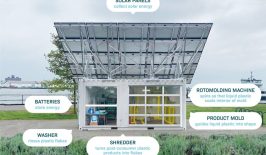I think it is fair to say the coronavirus pandemic has put significant strains on all sorts of sectors of society, from health to the overall economy. One area which saw a huge surge in demand during the lockdown has been delivery and logistic services. Of course, home delivery of goods and groceries is nothing new, but for many it became an essential lifeline during the darker months of the pandemic, and seems likely to only grow with increased urbanisation and a decrease in car ownership.
But, I’m also sure we have all dealt with moments of frustration with the current methods of deliveries – either goods not being delivered (despite sitting indoors all day to receive them!) or packages sent to depots on the far outskirts of the city. The traditional method of logistics also comes with significant environmental downsides. As demand for home delivery increases, so too does the amount of vans and trucks on our roads. In the UK, van traffic saw the fastest growth of any motor vehicle, almost doubling between 1993 to 2018 to reach a high of 51 billion vehicle miles. And with this growth, comes more carbon emissions.
However, new methods are being developed to tackle this issue. Some are relatively low-tech, such as using e-bikes for final mile deliveries in congested cities, while others seem on the cutting edge of science fiction. Take for example Magway, a UK-based startup which is exploring methods of transport goods across the country in high-speed, low emissions tubes.
Founded in 2017, Magway has ambitious plans. Its design is based on the principle of linear motors which can be used to propel objects along tracks at high speed. Unlike a traditional electric rotary motor, which creates rotary movement, a linear motor – as the name suggests – creates movement along a linear plane. The technology between the two is relatively similar. In a rotary motor, a magnetic field is used to spin a motor within a casing known as a stator. For a linear motor, this stator casing has been essentially cut open and laid flat. The linear motor then moves along the stator in a forward direction, riding on a cushion of air. Often, the more ambitious linear motor projects use superconducting magnets cooled to low temperatures in order to reduce power consumption.
A linear motor comes with distinct advantages over a traditional motor. First of all, with no moving parts it is much less likely to break down, while the cushion of air means no energy is lost to friction or vibrations. Additionally, no gear box is needed to convert a rotary motion into a straight line motion, again saving on energy.
For Magway, the technology provides a way to deliver goods speedily and conveniently across cities and potentially entire nations. They envision a network of 1-metre diameter tunnels in which automated Magway shuttles, powered by renewable energy, transport goods at high speed. With this system, Magway claims 90 percent of freight traffic could be removed from roads and highways.
The startup, which recently moved into a special facility and completed its first trial tracks, expects technology such as Magwy to form the logistical backbone of emerging smart cities. It can also build on pre-existing infrastructure, using the parking garages in apartments and offices as arrival points for packages.
Initially, it expects Magway routes to serve specific facilities, such as airports, but claims by 2023 it wishes to embark on long distance tunnels stretching potentially hundreds of kilometres alongside motorways.
Pipe Dreams?
In reality, the technology and concept themselves are not entirely new. The basic principles of linear motors were developed as far back as 1895, while the idea of tubes whizzing goods around cities is reminiscent of the now largely discontinued pneumatic tube systems which served for almost 100 years. Similar technology is also being experimented with to develop maglev (magnetic levitation) trains, or more worrying, the next generation of high velocity magnetic rail weapons.
So, if this technology has been around for a while – and seems to only provide advantages – why has it taken so long to become a reality? As with many many things, the issue largely surrounds cost. Linear systems are more expensive than rotary ones, especially the requirement for specially developed electromagnets. Furthermore, installing a linear motor system – for any purpose – would often require a vast overhaul of pre-existing infrastructure. In the case of maglev trains, an entirely new system of rails would need to be laid. Many maglev trains have actually been developed in the past, including the short lived M-Bahn in West Berlin. But as of 2022, only a handful remain in operation in Asia, with most providing short distance shuttle services to airports. It’s hard to imagine Magway’s dream of hundreds of kilometres of tunnels crisscrossing the nation would also not entail huge construction costs.
Despite this, the Magway system has certainly grabbed attention. Indeed, the system maybe more functional for logistics than it is for passenger travel. The design has won several awards already, and raised over 1.3 million GBP in crowdfunding in 2017. After a showcase as COP26, Magway has embarked on another round of crowdfunding in 2022 and has so far reached its target of 750,000 GBP with around a week left to go.









